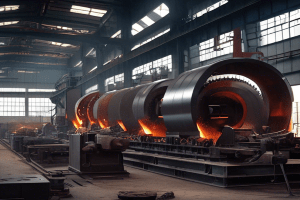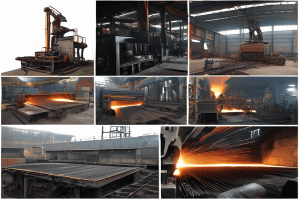History of steel making:
Steel, the actual spine of our advanced world, murmurs stories of transcending high rises, powerful extensions, and the cadenced bang of industry. Yet this omnipresent material, the ligament of progress, flaunts a set of experiences as rich and extraordinary as its properties.
Today, we set out on an excursion through time, uncovering the surprising adventure of steelmaking, from its red-hot starting points to its present-day omnipresence.
- Early Forges: Where Iron Met Innovation (3000 BC–18th Century AD)
Our story begins not with the roar of modern furnaces but with the gentle glow of ancient hearths. The earliest whispers of ironworking date back to 3000 BC, with rudimentary tools and weapons crafted from smelted iron. However, true steel, distinguished by its higher carbon content and superior strength, emerged much later. Around 1300 BC, the Hittites in Anatolia mastered the crucible technique, forging blades renowned for their exquisite sharpness and unwavering resilience.
Centuries later, India became a crucible of steel innovation. Wootz steel, famed for its intricate patterns and exceptional quality, adorned the blades of warriors and nobility across the ancient world. From Damascus to Toledo, weapons forged from wootz steel became prized possessions, testaments to the skill of Indian steelworkers.
- The Industrial Crucible: When Mass Met Metal (18th Century–20th Century)
The 18th century ushered in a new era with the Industrial Revolution. Puddling furnaces and rolling mills enabled mass production, but the process remained laborious and expensive. Enter Henry Bessemer in 1855. His revolutionary Bessemer converter breathed air into molten iron, dramatically reducing impurities and paving the way for affordable, mass-produced steel.
The Bessemer cycle lighted a steel boom, reshaping ventures and chiselling the cutting-edge world. From transcending high rises extending towards the sky to cross-country rail lines sewing landmasses together, steel became the pervasive material of progress. Further progressions, similar to the open-hearth heater and the electric curve heater, refined and broadened steel creation, taking special care of an always-developing interest.
- Sustainable Steels: Forging a Greener Future (20th Century–Present)
Today, steel remains the most utilized metal internationally, a demonstration of its unrivalled flexibility and properties. Yet, the story doesn’t end here. In the 21st century, we have seen a renewed focus on maintainability and natural obligations within the steelmaking business. High-strength, low-combination preparations are diminishing the load on vehicles and designs, while examination into cleaner creation processes means limiting the business’ carbon impression.
From old cauldrons to current heaters, the historical backdrop of steelmaking is an adventure of human resourcefulness and persevering transformation. As we look towards the future, steel’s perseverance through heritage vows to keep molding our reality, helping us to remember the groundbreaking force of a material fashioned in the flames of development.
Steel making process steps:
1. Ironmaking: Transforming Ore into Molten Metal
- Raw materials: The process begins with iron ore, limestone, and coke (produced from coal).
- Blast furnace: These towering furnaces reach up to 30 meters tall and burn incredibly hot (around 2000°C). The coke reacts with the oxygen in the air, producing carbon monoxide.
- Chemical dance: As the iron ore descends through the furnace, the carbon monoxide removes oxygen from the ore, converting it into molten iron. Limestone melts and combines with impurities in the ore, forming slag, which floats on top of the molten iron.
- Tapping the furnace: Periodically, molten iron and slag are tapped from the furnace. The slag is skimmed off, and the molten iron, now called “hot metal,” is ready for the next step.
2. Steelmaking: Refining the Molten Metal
- There are two main methods: Today, steelmaking primarily uses either the Basic Oxygen Steelmaking (BOS) process or the Electric Arc Furnace (EAF) process.
- BOS process: Molten iron is poured into a large vessel called a converter. Oxygen is blown through the molten iron, burning out impurities like carbon and manganese. Alloying elements like chromium or nickel are also added at this stage to give the steel its desired properties.
- EAF process: This method uses electricity to melt scrap steel and sometimes pig iron (molten iron with a high carbon content). Similar to the BOS process, oxygen, and alloying elements are added to refine and adjust the steel’s properties.
3. Casting and Shaping: Giving Form to the Molten Steel
- Continuous casting The most common method is when molten steel is poured into a mould with a continuously moving bottom. As the steel cools and solidifies, it’s pulled through the mould, forming slabs, blooms, or billets of desired shapes and sizes.
- Other methods: Depending on the final product, steel can also be cast into specific shapes using molds or further processed through hot rolling, cold rolling, and other shaping techniques.
4. Finishing Touches: Enhancing Properties and Appearance
- Heat treatment: Steel can be heated and cooled in controlled ways to modify its strength, ductility, and other properties.
- Surface treatments: Galvanising, coating with zinc, or applying other finishes can protect the steel from corrosion and enhance its appearance.
And that’s the basic journey of steel! From humble iron ore to the versatile and vital material that shapes our world, the steelmaking process is a testament to human ingenuity and technological prowess.
I hope this explanation, along with the images, gives you a clearer picture of the amazing steps involved in creating steel! Let me know if you’d like to delve deeper into any specific stages of the process.


